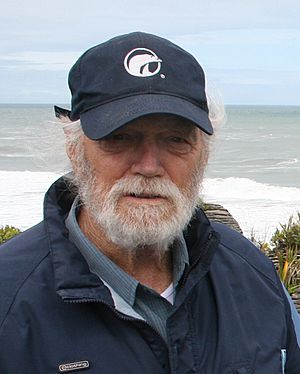David McNiven Garner facts for kids
Quick facts for kids
David McNiven Garner
|
|
|---|---|

Garner, taken at Pancake Rocks, near Punakaiki, Westland, New Zealand in 2008
|
|
| Born | 26 November 1928 Wanganui, New Zealand
|
| Died | 13 May 2016 (aged 87) Dunedin, New Zealand
|
| Alma mater | Victoria University New York University |
| Scientific career | |
| Fields | Physical oceanography |
| Institutions | Department of Scientific and Industrial Research, New Zealand Bedford Institute of Oceanography University of Auckland |
David McNiven Garner (born November 26, 1928 – died May 13, 2016) was a smart scientist from New Zealand. He was a physicist who studied the ocean, especially how ocean currents move. This field is called physical oceanography.
Contents
David Garner's Journey in Ocean Science
Early Studies and Return to New Zealand
David Garner went to New York University in the United States from 1959 to 1962. There, he earned his PhD (Doctor of Philosophy) in Physics in 1962. A PhD is a very high university degree that shows someone is an expert in their field.
After finishing his studies, Dr. Garner came back to New Zealand in 1962. He joined a group of scientists who started the New Zealand Oceanographic Institute. This institute was part of the Department of Scientific and Industrial Research (DSIR). Today, this organization is known as the National Institute of Water and Atmospheric Research.
Working in Canada
In 1968, David and his family moved to Canada. He worked as a physical oceanographer at the Bedford Institute of Oceanography in Nova Scotia. He stayed there from February 1968 to July 1971. While in Canada, he researched how the Mid-Atlantic Ridge affected ocean currents. The Mid-Atlantic Ridge is a huge underwater mountain range in the Atlantic Ocean.
David worked a lot on special research ships called CSS Dawson and CSS Hudson. CSS stands for Canadian Scientific Ship. These ships were used to explore the ocean. He even took part in a historic trip in 1970. The CSS Hudson was the first ship to ever sail all the way around both North and South America! David was a watch keeper on this amazing voyage.
Back to New Zealand and Offshore Drilling
David returned to New Zealand with his family in 1971. He became a senior lecturer in the Physics Department at the University of Auckland. He taught there from about 1971 to 1974. During this time, he helped with an important study. The university was looking at how offshore drilling might affect the environment. Offshore drilling is when companies drill for oil or gas under the ocean. David used his knowledge of oceanography to help with this report.
David's Early Life and Interests
First Job and Film Appearance
After finishing high school in 1946, David couldn't go straight to university. This was because people who had served in World War II were given first choice. So, he got a job for a year (1946–47) with the Department of Scientific and Industrial Research. He worked on a project called the Meteorological Sounding Team Canterbury Project. This team used radar to study the weather. They were based at the Ashburton Aerodrome.
The New Zealand National Film Unit even made a short film about their work! It was shown in cinemas before the main movie. The film shows David getting into an Avro Anson airplane. It also shows him working with a special kite on the back of a truck, and even on a fishing boat.
University Studies and Sunspot Research
David later attended Canterbury College. Then he moved to Wellington and earned his Bachelor of Science (BSc) and Master of Science (MSc) degrees from the Victoria College of the University of New Zealand.
After graduating, David worked at the Carter Observatory in Kelburn, Wellington. There, he researched sunspots. Sunspots are dark, cooler areas on the Sun's surface. This is where he published his very first scientific paper!
Family Life
David Garner had three children with his wife, Edna Jean Garner: Mary Ann, John David, and Steven James. His later wife was Kirsty Garner. David Garner passed away on May 13, 2016.

